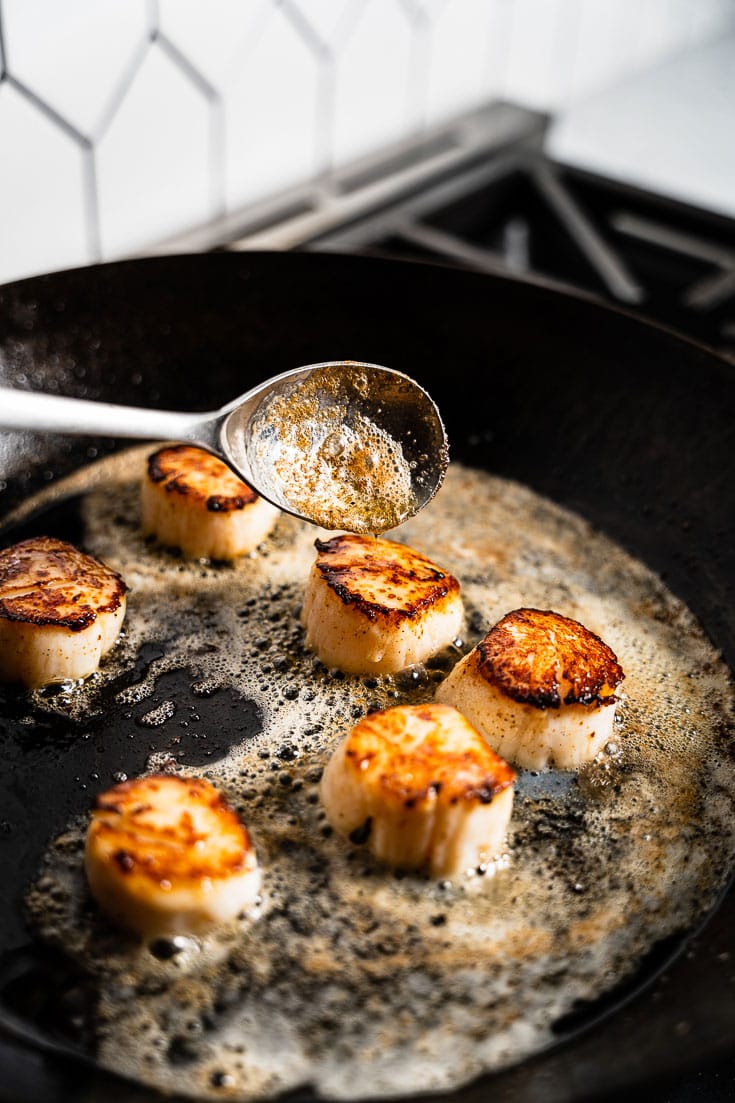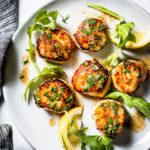Perfectly pan seared scallops. You love them, but do you know how to make them? After reading this, you definitely will. Pan-seared scallops are a quick-cooking masterpiece just waiting for your dinner party table.
A little experience goes a long way when it comes to cooking scallops. But don’t worry, you can perfect it on your first try, too.
How to Sear Scallops
- Start with rinsed and thoroughly dried scallops. Heat a large heavy-bottom skillet over high heat with enough canola oil to coat the bottom. Season the scallops on all sides with kosher salt and freshly ground pepper. When the oil just starts to smoke, place the scallops in the skillet.
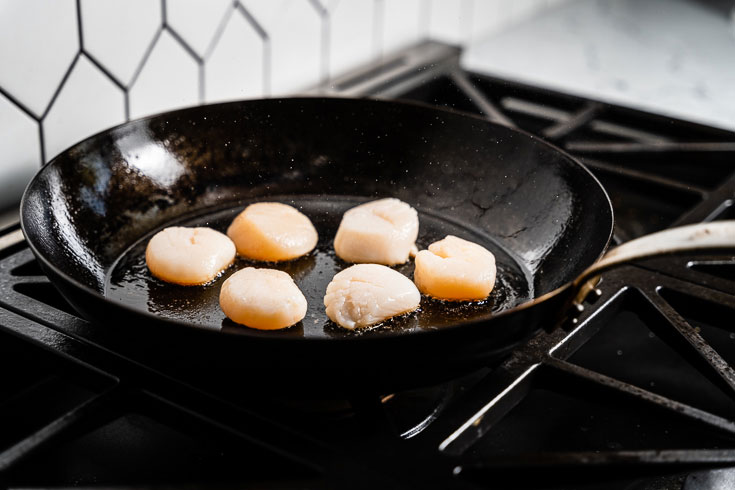
2. Cook on the first side for about 2 minutes, or until they are golden brown. If they are sticking, that means they aren’t ready to flip yet.
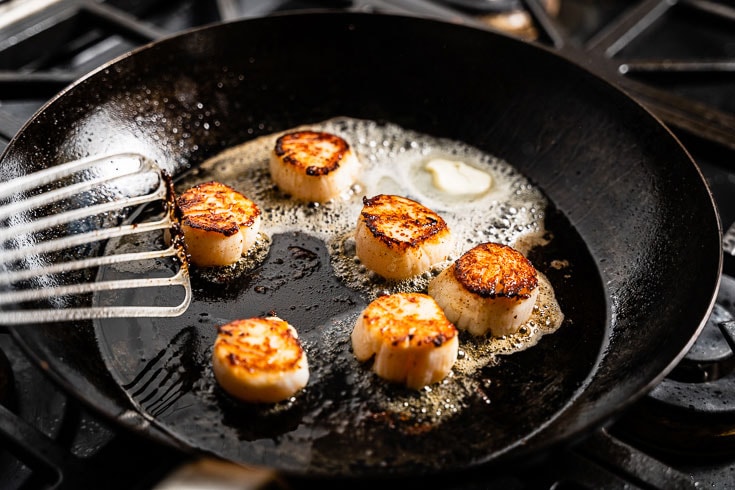
3. Turn the scallops over with a fish spatula, add 1 tablespoon of butter and reduce the heat to medium-low. Baste the butter over the scallops while they finish cooking for about 1 minute more, or until the internal temperature reaches 115° F. The temp will rise about 10 to 15° more when removed from the skillet.
4. Optionally, finish with a squeeze from half a lemon and some fresh parsley
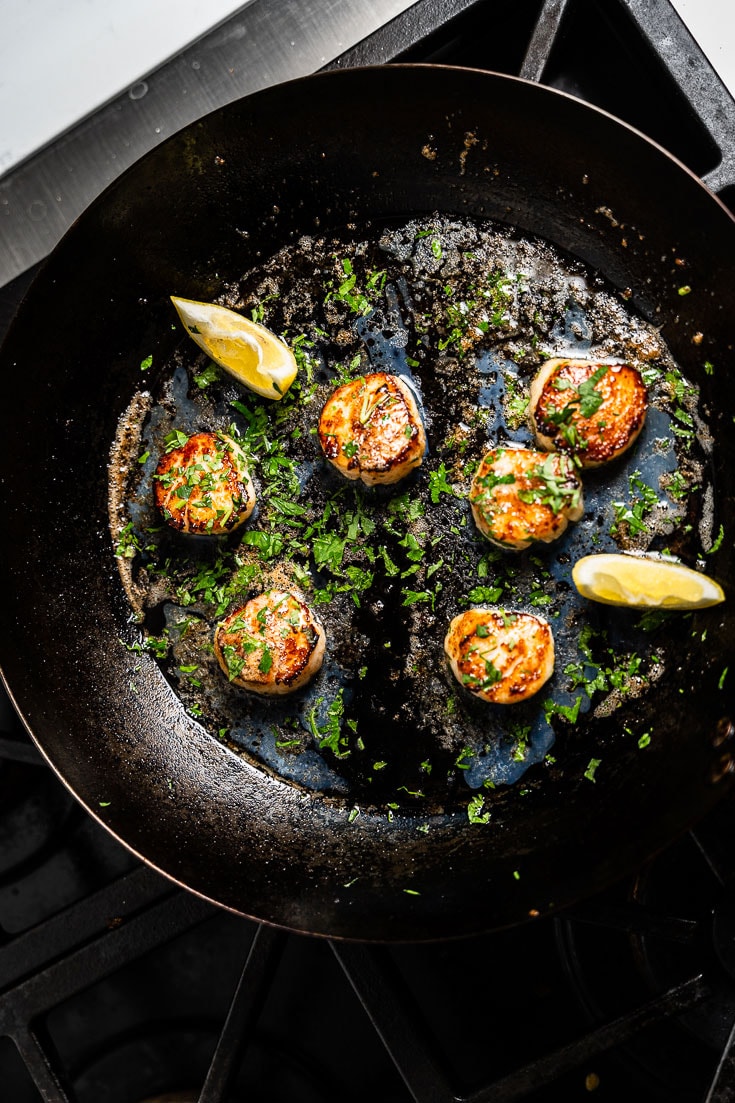
Pro Tips for Success
- A dry scallop is a happy scallop when it comes to searing. Not just using “dry” scallops, but patting them dry before cooking to remove as much excess moisture as possible so they sear instead of steam.
- Remove the side muscle as it becomes tough when cooked. These simply peel right off and can be discarded.
- Use enough oil to coat the skillet. Since there’s little fat in a scallop, the scallops can stick and burn if there isn’t a layer of fat between them and the pan.
- Season right before cooking and not before, as the salt will pull out moisture if they sit too long.
- Don’t overcrowd the pan. Use a larger pan than you think you will need, as the pan will cool down too quickly when the scallops are added if it is too small.
- Sear the presentation side (prettiest side) first and cook longer on the first side. Don’t worry about getting the second side brown, as that will usually cause the scallop to overcook.
- After the scallops are finished cooking, immediately remove them from the skillet to prevent overcooking.
- Stock your freezer with frozen scallops for a quick meal, as they defrost in water in about 10 minutes.
Top Problems / Reasons the Scallops Didn’t Sear (turn golden brown)
- The scallop was too damp, which will cause them to steam.
- The pan wasn’t hot enough.
- Didn’t sear long enough on the first side.
- Didn’t use enough oil.
What Is a Scallop?
Scallops are a family of bivalve mollusks, like clams and oysters, in that they have hinged, two-sided shells. But scallops are unique in a couple of ways: They have eyes, and they can swim rapidly for short distances using jet propulsion. Both of these adaptations allow them to escape predators, like starfish and rays.
The flavor of a scallop is sweet and the texture is delicate when cooked right.
Calories in Scallops / Scallop Nutrition
A serving of 3 oz. of scallops, has just under 100 calories, and these nutritious little wonders are low in fat, high in protein and loaded with omega-3 fatty acids and vitamins and minerals. They do not bioaccumulate toxins (like mercury) as other seafood can, so no worries there. Some people are allergic to scallops, so be careful if you’re serving to guests.
The Difference Between Bay and Sea Scallops
The scallops you’ll want to use for this dish are Atlantic sea scallops, a large scallop species, which when prepped are at least an inch in diameter. These scallops are usually harvested by dredging, which is rough on the marine environment. Sometimes they are harvested by hand by divers (“diver scallops”), and these tend to be of the highest quality and contain less grit.
Get diver scallops if you can, though sometimes dredged scallops are labeled as diver scallops. Farmed scallops are fine to buy, if they are Atlantic sea scallops, as scallop aquaculture is generally considered environmentally benign.
Bay scallops (“calico scallops”) are much smaller, harvested in shallower waters and are about the size of a grape when prepped. While delicious, these scallops aren’t great for entrees, and are less abundant than sea scallops due to habitat loss.
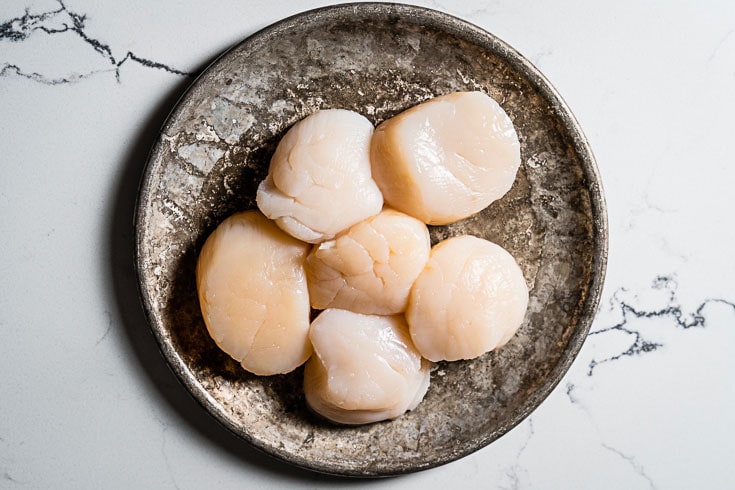
Dry vs Wet Scallops
Scallops are often shucked right on the boat, and frozen soon after shucking; the meat texture isn’t harmed by freezing. But you will want to buy “dry packed” scallops, which are packed without added water or preservatives. Dry scallops will tend to be fresher and tastier, as the added water in “wet” or “soaked” scallops dilutes the flavor. Dry scallops in the package are off-white or pinkish, while wet scallops will be bright white because of added chemicals.
If all you can find are wet scallops, you can soak them for 30 minutes in a quick brine of 1/4 cup lemon juice and two tablespoons salt in a quart of water to improve the flavor.
Cleaning the Scallops
Simply run them under cold water to give them a quick rinse, and then place them onto a paper towel-lined plate to start the drying process. You shouldn’t feel any sand or grit after rinsing.
Removing the Side Muscle
When you eat a scallop, usually the only part you are eating is the round adductor muscle that opens and closes the shell; the rest of the scallop is typically discarded when it is shucked (some dishes include certain other parts). Scallops, however, almost always come with the side muscle or tendon attached. It’s just a little extra tag on the main muscle. While it might look innocent, it gets very tough when cooked and should be removed. Simply peel it off when you are cleaning the scallops.
What Is the Best Way to Cook Scallops?
Cooking scallops in a pan is definitely the best way. It gives you the most control and allows you to make a quick and easy pan sauce at the same time. Grilling the scallops can add a slightly smoky flavor and grill markings, but the flavor from the sear is inferior, and it’s easier to overcook the scallops on the grill and they can stick.
What Is the Best Oil to Cook Scallops?
Use a neutral oil with a high smoke point such as canola or grapeseed oil when cooking scallops. Since they cook at such a high temperature, olive oils can burn, causing undesirable flavors.
Different Skillets Compared
The skillet you use can make all the difference when it comes to getting the perfect sear on your scallops. A skillet that has good heat retention is key to that golden brown crust.
Carbon Steel: Heat retention, heat tolerance and built-in nonstick (when properly seasoned) make carbon steel my favorite skillet for searing scallops.
Cast Iron: A well-seasoned cast-iron skillet can work great as it stays very hot and gives great sear. If it’s not seasoned well, then a fishy flavor can remain in the skillet and reappear the next time you use it.
Stainless Steel: Stainless skillets can work great, but you have to be careful about the scallops sticking if you don’t use enough oil. They can also be difficult to clean.
Non-Stick: Not great for high-heat searing and the smoke fumes coming off of it can be harmful. The “non-stick” coatings can limit its browning ability. Save these for lower-temperature cooking and eggs. If you do have to use a non-stick skillet, try using butter as the fat, which will promote the browning of the scallops at a lower temperature.
How to Tell When Scallops Are Done?
Probing with an instant-read thermometer will tell you precisely when the scallops are cooked through. Going off of cook time is tricky, as the size of scallops varies greatly. Since they are seared in such a hot skillet, it’s important to be aware of the carry-over cooking that will happen. For this reason, you want to remove them from the skillet as soon as they are done. They will toughen up quickly and definitely don’t benefit from cooking too long.
While a thermometer is the best way to tell when they are done, you can also tell visually. As soon as they become opaque, they are done cooking.
What to Serve with Scallops
- Roasted mushrooms
- Arugula salad with a lemon vinaigrette
- Sauteed broccolini
- Cauliflower puree
- Kale salad with a miso vinaigrette
- Creamy mashed potatoes
- A simple pasta with butter, capers, lemon and Parmesan
- Soft vegetables that don’t overpower the delicate texture
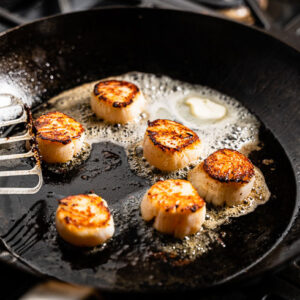
Seared Scallops
Ingredients
- 1 pound sea scallops (preferably dry packed, defrosted)
- Diamond kosher salt
- Freshly ground pepper
- Canola oil or other neutral oil
- 1 Tbsp. Unsalted butter
Optional to finish
- 2 small chopped shallot (optional)
- 1 Tbsp. chopped Italian parsley
- 1/2 lemon
Instructions
- Prep the scallops by rinsing under cold water and removing the side connector muscle. Place the scallops on a paper towel-lined baking sheet or plate and pat dry with more paper towels.
- Preheat a large skillet over high heat with enough oil to just coat the bottom of the pan.
- While the pan heats, season the scallops on all sides with salt and pepper.
- When the oil just starts to smoke, carefully place the scallops presentation side down in the skillet and sear for about 2 minutes, or until golden brown.
- Turn the scallops to the second side with a fish spatula (or spoon). Reduce the heat to medium-low and add the butter and optional shallot.
- Using a spoon, baste the melted butter over the scallops while they finish cooking for about 1 to 1 1/2 more minutes. Cook to 115° F internal temperature, which will continue to rise by 10 to 15° as they were cooked in a high heat pan, to a perfect 125° F.
- Finish with fresh parsley and a squeeze from half a lemon and immediately remove from the skillet from the stove (to stop the cooking) and serve with the lemon-butter pan sauce.
Notes
- If you’re using frozen scallops, defrost them for 10 minutes in a bowl of water.
- Remove connector muscle before cooking as it will become tough.
- Olive oil is not recommended for searing scallops as it has a lower smoke point.
- The cook time will vary depending on the size of the scallops. Cook to an internal temperature of 115° F, which will rise another 10 to 15° after they are removed from the skillet.
- 1 pound of scallops can serve 2 to 4 people, depending on the size and how many you serve per person.

